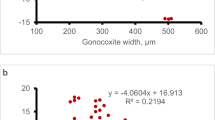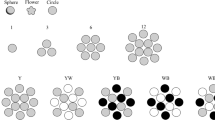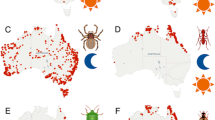Abstract
How tiny insects respond to prevailing rainfall events to protect themselves from water droplets is poorly known. If such insects could anticipate impending rainfall and take shelter to avoid being hit by rain drops their chances of surviving such events would be increased. Some insect species can detect atmospheric pressure changes associated with rainfall events and respond accordingly. Laboratory experiments were conducted on the flower thrips Frankliniella schultzei to discern whether they adjust their behavior in response to atmospheric pressure change. F. schultzei mating frequency and shelter seeking behaviors were assessed under a range of different atmospheric pressure regimes including, a rapid change in atmospheric pressure (50 hPa/h), designed to simulate atmospheric changes associated with cyclonic conditions, and a slower rate of change (20 hPa/h), that is commonly associated with rainfall. The mating frequency of the thrips was significantly reduced in response to rapid changes in atmospheric pressure, whereas the slower rate had no such effect. These results indicate that F. schultzei is capable of detecting atmospheric pressure changes. The shelter seeking behaviors of each sex were assessed under the same two atmospheric pressure regimes. The thrips did not seek shelter significantly more or less under either pressure regime. Field experiments are now required to clarify if the ability to detect pressure is used by these thrips to protect themselves before the onset of rainfall events.



Similar content being viewed by others
References
Ankney PF (1984) A note on barometric pressure and behavior in Drosophila pseudoobscura. Behav Genet 14:315–317
Breuner CW, Sprague RS, Patterson SH, Woods HA (2013) Environment, behavior and physiology: do birds use barometric pressure to predict storms? J Exp Biol 216:1982–1990. doi:10.1242/jeb.081067
Chang MEK, Lee S, Swanson KL (2002) Storm track dynamics. J Clim 15:2163–2183
Dickerson AK, Shankles PG, Madhavan NM, Hu DL (2012) Mosquitoes survive raindrop collisions by virtue of their low mass. Proc Natl Acad Sci U S A 109:9822–9827. doi:10.1073/pnas.1205446109
Fournier F, Pelletier D, Vigneault C, Goyette B, Boivin G (2005) Effect of barometric pressure on flight initiation by Trichogramma pretiosum and Trichogramma evanescens (hymenoptera: trichogrammatidae). Environ Entomol 34:1534–1540. doi:10.1603/0046-225X-34.6.1534
Ibrahim ND, Adesiyun AA (2010) Effect of rainfall in the control of onion thrips, Thrips tabaci Lindeman (thysanoptera: thripidae) in sokoto, niger. Agric Biol J N Am 1:377–386
Kakkar G, Seal DR, Jha VK (2010) Common blossom thrips, Frankliniella schultzei Trybom (Insecta: Thysanoptera: Thripidae). Entomology and nematology department, Florida cooperative extension service, institute of food and agricultural sciences, university of Florida. http://edis.ifas.ufl.edu/in860. Accessed 7 July 2013
Kirk WDJ (2004) The link between cereal thrips and thunderstorms. Acta Phytopathol Entomol Hung 39:131–l36. doi:10.1556/APhyt.39.2004.1-3.1
Lowry R (1998) Vassarstats: website for statistical computation [computer software]. http://vassarstats.net/index.html. Accessed 15 November 2014
Marchand D, McNeil JN (2000) Effects of wind speed and atmospheric pressure on mate searching behavior in the aphid parasitoid Aphidius nigripes (hymenoptera: aphidiidae). J Insect Behav 13:187–199. doi:10.1023/A:1007732113390
Milne M, Walter GH (1997) The significance of prey in the diet of the phytophagous thrips, Frankliniella schultzei. Ecol Entomol 22:74–81. doi:10.1046/j.1365-2311.1997.00034.x
Milne M, Walter GH, Milne JR (2002) Mating aggregations and mating success in the flower thrips, Frankliniella schultzei (thysanoptera: thripidae), and a possible role for pheromones. J Insect Behav 15:351–368. doi:10.1023/A:1016265109231
Milne M, Walter GH, Milne JR (2007) Mating behavior and species status of host-associated populations of the polyphagous thrips, Frankliniella schultzei. J Insect Behav 20:331–346. doi:10.1007/s10905-007-9081-4
Mizoguchi H, Fukaya K, Mori R, Itoh M, Funakubo M, Sato J (2011) Lowering barometric pressure aggravates depression-like behavior in rats. Behav Brain Res 218:190–193. doi:10.1016/j.bbr.2010.11.057
Mound LA (2004) Australian thysanoptera - biological diversity and a diversity of studies. Aust J Entomol 43:248–257. doi:10.1111/j.1326-6756.2004.00431.x
Paige KN (1995) Bats and barometric-pressure: conserving limited energy and tracking insects from the roost. Funct Ecol 9:463–467. doi:10.2307/2390010
Pellegrino AC, Peñaflor MFGV, Nardi C, Bezner-Kerr W, Guglielmo CG et al (2013) Weather forecasting by insects: modified sexual behaviour in response to atmospheric pressure changes. PLoS One 8(10):e75004. doi:10.1371/journal.pone.0075004
Preacher KJ (2001) Calculation for the chi-square test: an interactive calculation tool for chi-square tests of goodness of fit and independence [computer software]. http://quantpsy.org. Accessed 5 October 2013
Price PW (1998) Insect ecology, 3rd edn. Blackwell, London
Rafter MA, Walter GH (2013) Mate recognition in the south African citrus thrips Scirtothrips aurantii (Faure) and cross-mating tests with populations from Australia and south africa. J Insect Behav 26:780–795. doi:10.1007/s10905-013-9391-7
R Development Core Team (2009) R: A language and environment for statistical computing. R Foundation for Statistical Computing, Vienna, Austria. http://www.R-project.org
von Bartheld CS, Giannessi F (2011) The paratympanic organ: a barometer and altimeter in the middle ear of birds? J Exp Zool B Mol Dev Evol 316:402–408. doi:10.1002/jez.b.21422
Weisser WW, Volkl W, Hassell MP (1997) The importance of adverse weather conditions for behaviour and population ecology of an aphid parasitoid. J Anim Ecol 66:780–780. doi:10.2307/5984
Acknowledgments
We thank our laboratory colleagues Rehan Silva and Phoebe Coulon-McIntosh for their assistance with this study and our friend Emmanuelle Zoccola for her advice and support.
Author information
Authors and Affiliations
Corresponding author
Electronic supplementary material
Below is the link to the electronic supplementary material.
Supporting information 1
(DOCX 24 kb)
Fig S1
The number of adult Frankliniella schultzei, by sex, that made first contact with one of the shelters (tubes or flower, as specified) during three assays of shelter seeking behavior. The shelters in the first (control) assay were not flowers, but two identical black tubes. The second assay tested the attractiveness of a red tube relative to a black one. The third assay tested the relative attractiveness of a red tube and a Malvaviscus arboreus flower (also red). (TIFF 5884 kb)
Rights and permissions
About this article
Cite this article
McFarlane, D.J., Rafter, M.A., Booth, D.T. et al. Behavioral Responses of a Tiny Insect, the Flower Thrips Frankliniella schultzei Trybom (Thysanoptera, Thripidae), to Atmospheric Pressure Change. J Insect Behav 28, 473–481 (2015). https://doi.org/10.1007/s10905-015-9516-2
Revised:
Accepted:
Published:
Issue Date:
DOI: https://doi.org/10.1007/s10905-015-9516-2




